Part 3: Two Weeks in Idaho (mostly):
a Motorcycle Adventure
September 2016
DRAFT
Introduction and Part 1 (Hell's Canyon drive from
Oxbow Bridge along the Snake River to the Hell's Canyon dam and then back
over Oxbow dam to Cambridge, Idaho, and everything up to Part 2)
Part 2: Historic Silver City, Idaho
Monday (Day Four)
On our way out of Silver
City, Idaho, I'd formed the plan that we would stop for lunch in the
nearest real city and, while eating, I would call Progressive Insurance. We
pay for roadside assistance! We were now on Idaho state road 78, headed to
Murphy. We immediately realized it was a tiny town that had no restaurants -
but it does have an air strip right along the road and we
got to see a plane land. Stefan's tire was holding up, so we headed to
Nampa. We stopped for lunch at Idaho Pizza, and while we ate, I called
Progressive Insurance.
I spoke slowly. I thought I made the directions clear: Stefan's motorcycle
had a flat, it was probably the innertube, not the tire, and we needed to be
taken to a place in Nampa that was willing to change the innertube on a
motorcycle. Progressive has all the information on Stefan's motorcycle, they
knew it was a MOTORCYCLE. The woman I talked to seemed to be understanding
what I was saying.
A tow truck driver showed up. He'd been told he would be towing a small car.
He'd been told by Progressive to take the small car to Discount Tire. Stefan
stared at him incredulously. "They don't work on motorcycles. They don't do
anything with motorcycles." The driver said, "Well, that's where I've been
told to take you." I told the tow truck driver to call the tire place and
confirm - he did and, of course, Stefan was right: they don't work on
motorcycles. The driver said that Canyon Honda, a motorcycle shop, might be
able to help us, and he called them for us - he could have just left us
because, afterall, he'd done what Progressive told him to do. At first, the
dealership told him no - they just didn't have the time to help us that day.
The driver told him we were a couple from Oregon, traveling through Idaho,
that we were stranded unless we got the tire fixed, and they relented. Part
of the reason they relented was our driver knew at least two of the guys at
the shop personally. Stefan's tire was still looking good, so the tow truck
driver suggested we follow him to the dealership. And we did.
Oh, yes, when I got back, I wrote all this to Progressive. The response from
Progressive:
We apologize for not living up to the high standards we set for
ourselves.
We'll forward your experience to the appropriate department so that we can
prevent this from happening again.
We appreciate your business and the trust you place in us.
That's it! No explanation of why this happened, if this was supposed to
happen or if it was, indeed, supposed to go differently, no assurance that
next time we need roadside assistance, Progressive will actually give us
roadside assistance - just this incredibly ineffective non-apology
apology. So I complained again, and this time, found out Progressive
outsources its roadside assistance to some company called Agero. A rep from
Agero called and read a prepared statement that is obviously something they
recite to every person who calls to complain. I sat there on the phone,
listening to the recitation, and thought, ARE YOU FREAKIN' KIDDING ME? The
rep never said, "Oh, absolutely, the representative should have known to
call motorcycle dealership and dirt bike shops to find someone to replace
that tire tube." Or, "Hey, that was really awful, I'm sending you a $50 gas
card!" Nope, just a recited apology prepared by some public relations
department somewhere and an assurance that next time - no, really, NEXT TIME
- it will all work out.
Now searching for insurance that actually provides roadside assistance to
motorcyclists, as Progressive / Agero clearly does not do so.
Canyon Honda,
by the way, was wonderful. I fully expected to have to wait many
hours, and the dealership would have been justified in making us wait,
because they had a lot of customers ahead of us, but they put
Stefan's bike up on the rack almost immediately. No hole was ever
found in the tire, and the mechanic said the hole in the tube was quite
small. He was really worried that, even with the new tube, he wasn't really
fixing the problem. Spoiler alert: he did fix it. The fee they charged was
quite reasonable, and we had no more tire problems for the rest of the trip.
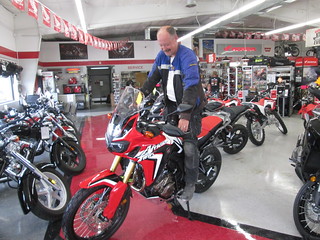 While
waiting for the tire fix, Stefan
got to see a new Honda Africa Twin in person. The original version of
the bike, the one he has, was never sold in the USA, and it stopped being
made altogether in 2003 - or, at least, they ran out of stock and stopped
selling it then. This new version just started production, and the dual
sport world has been all abuzz about it. He
looked good on it! The Canyon Honda staff were all super nice, spent a
lot of time with us in the showroom that they didn't have to, and we so
appreciated them working us in to fix the bike. Since Progressive / Agero
was no help, we will always be thankful to that tow truck driver for taking
us there and sweet talking them into fixing the tire for us.
While
waiting for the tire fix, Stefan
got to see a new Honda Africa Twin in person. The original version of
the bike, the one he has, was never sold in the USA, and it stopped being
made altogether in 2003 - or, at least, they ran out of stock and stopped
selling it then. This new version just started production, and the dual
sport world has been all abuzz about it. He
looked good on it! The Canyon Honda staff were all super nice, spent a
lot of time with us in the showroom that they didn't have to, and we so
appreciated them working us in to fix the bike. Since Progressive / Agero
was no help, we will always be thankful to that tow truck driver for taking
us there and sweet talking them into fixing the tire for us.
We went back down the road through Murphy, and decided to head to Bruneau
Dunes State Park, about 60 miles away. We got there at 8, it was still
daylight, and were pleased to find we were the only campers there, and it
stayed that way while I took a shower and washed some things in the bathroom
sink. I love this state park - the bathrooms, the shelters
for picnic tables at tent sites, the incredible views of the night
sky... but I'd really love to go some weekend when we could visit the site's
planetarium. I was also SO tired of these long days. I like being in a camp
site by 6, at the latest. I like time to read whatever book I've brought -
which I hadn't been able to do even once on this trip. The end of every day
saw us absolutely exhausted. It was hard to get the energy to even write in
my travel journal.
That night, we hung
laundry to dry and cooked supper for the first time - just some canned
soup and bread. We drank beer and star gazed, just like we had done every
night - and it's a wonderful way to end every evening. This time, I did see
a shooting star with a tail, along with lots of other falling stars. There
were lots of fighter planes going over us as well, and I kept saying, "I
hope we haven't gone to war and we don't know because we haven't seen the
news!" It was so hot, we
didn't use the rain fly on the tent. It was also so quiet, we had to
whisper in order to not disturb the other campers. I know how voices carry
in a campground - I've been kept awake by people having a conversation in
full voice at midnight across a campground. And with that said, thank you,
Bruneau Dunes State Park staff, for all the signs in the bathroom asking
people to PLEASE be quiet; I know some people see it as nagging, but I
really, hugely appreciate the reminders.
A word about Idaho camp sites. I totally get that non-Idaho residents have
to pay more than Idaho residents. But round off charges; I don't always have
the odd amount of change you ask for at camp sites, like 14 cents.
And, by the way: I'm
still not a backrest.
Tuesday, Day Five
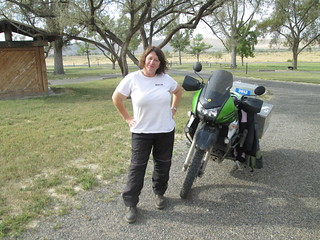 It
cooled off in the night. Oh how glorious it felt. But the day was quickly
heating up - another day hot-as-Hades. We walked around the campground,
something I like to always do the night we arrive or in the morning, to
stretch my legs and rest my mind. We found horseshoes at the other end of
the park and tried to play. We're really, really bad! Even with that walk,
we were ready to leave at 10 a.m. Mountain time.
It
cooled off in the night. Oh how glorious it felt. But the day was quickly
heating up - another day hot-as-Hades. We walked around the campground,
something I like to always do the night we arrive or in the morning, to
stretch my legs and rest my mind. We found horseshoes at the other end of
the park and tried to play. We're really, really bad! Even with that walk,
we were ready to leave at 10 a.m. Mountain time.
We debated skipping City of Rocks, which is on the other side of the state,
but decided to go anyway. But that meant taking the interstate for a bit. It
was wretched. Oh how I hate the interstate. I just really hate going that
fast - everyone is going at least 10 miles over the speed limit, and I
really don't like going faster than 65 mph on my bike. We got off at Bliss,
and at the service station, met a big group of very young firefighters based
in Merlin, Oregon, headed to fires in Utah. They just all looked so young to
me... not old enough to fight fires! Any that could grow beards had beards -
a couple of guys, and the young woman with them, didn't have such.
We passed a sign for Hagerman
Fossil Beds National Monument. We didn't stop, and I wondered if we
should have. That happens a lot on these trips: you pass something you
didn't know was on the way during your trip and think, should we stop there?
And then you do, and it's either awesome or boring, you just never know.
Anyway, reading about it later: In 1929 and 1930, James Gidley of the
Smithsonian Institution excavated what is now known as the Hagerman Horse
Quarry. These excavations uncovered the largest assemblage known of the
first single-toed horse, Equus simplicidens. The Smithsonian
excavations resulted in the collection of more than 20 complete horse
skeletons and material from more than 200 other individuals. Since
those original Smithsonian excavations, tens of thousands of additional
fossils have been found, and new fossils, including those of new species,
continue to be discovered. Today, paleontological specimens from Hagerman
Fossil Beds are housed on-site in the park collections and at more than 40
academic institutions across the USA. Seldom are complete skeletons of an
animal found; most of the fossils newly discovered are small, and may be
teeth, scales, or parts of jaws or other bones. There are no open pits to
view or field units doing current collecting of fossils at the monument.
Part of the route we went on was the Thousand Springs Scenic Byway, probably
the least scenic byway we took on the entire trip, but still better
than the interstate. The byway goes through a few dying small towns. At one
point on the road, there were several springs creating
water falls out of cliffs, but there was no public viewpoint - just
fenced in fee-based cabins, campsites and swimming pools, meaning you had to
pay to see the view. We skipped Shoshone Falls and the Evel Knievel Snake
River jump site as well - I know, how could I pass up such important USA
history? Our impression of Twin Falls: land of many motels.
We had lunch in the little town of Buhl at a Mexican restaurant in a former
movie theater, and the owner was hilarious. While at the restaurant,
I had Internet access for the first time on the trip, so I decided to check
the news - and I saw that Gene Wilder had died. And I immediately teared up.
I love him so much! Stefan's favorite movie of his is The Producers,
my Mom's favorite movie of his is Silver Streak, and I know most
people love him most as Willy Wonka. And I adore him in all those roles. But
my favorite of his work is Young Frankenstein. I think he goes from
being fun to being brilliant in that role.
Speaking of movies, nearby was the Parlor
Antiques store, and in the window was a Rex
Harrison-as-Doctor Dolittle doll. But couldn't I buy it and pretend
it's a Henry Higgins doll?
We pushed on, and the heat was exhausting. It was stupid hot. I was doing my
best to drink water whenever we stopped, which meant I had to pee a lot. I
was getting snappy - I don't like riding when I'm so tired. We stopped at a
Dairy Queen for an hour, just to cool off. I just couldn't go on. And while
there, I was reminded of just how wretched modern country music is. It's
CRAP. We had passed through tiny, all-but-dead towns with no gas, no
groceries, and not all that scenic. It was depressing.
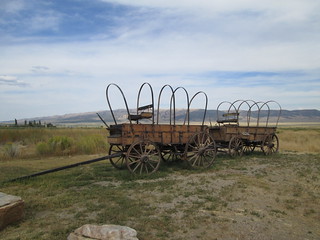 We
went through Almo, Idaho, which is advertised as historic, but just seemed
like another sad, barely-hanging-on small town. I found out later that the
town long commemorated a massacre
of pioneers by Indians that probably never happened: in 1938, the Sons
and Daughters of Idaho Pioneers erected a marker in remembrance of the Almo
Massacre of 1861, in which, supposedly, a wagon train of nearly 300 pioneers
was surrounded and slaughtered by Indians. However, the earliest written
record of this event is from 1927, and the total absence of information
about either the slaughtered pioneers or the six survivors has led the Idaho
State Historical Society to recommend the removal of the marker. And so:
good for the Idaho State
Historical Society for righting this wrong! Let's face it: most
massacres went the other way, and are rarely commemorated with a monument.
We
went through Almo, Idaho, which is advertised as historic, but just seemed
like another sad, barely-hanging-on small town. I found out later that the
town long commemorated a massacre
of pioneers by Indians that probably never happened: in 1938, the Sons
and Daughters of Idaho Pioneers erected a marker in remembrance of the Almo
Massacre of 1861, in which, supposedly, a wagon train of nearly 300 pioneers
was surrounded and slaughtered by Indians. However, the earliest written
record of this event is from 1927, and the total absence of information
about either the slaughtered pioneers or the six survivors has led the Idaho
State Historical Society to recommend the removal of the marker. And so:
good for the Idaho State
Historical Society for righting this wrong! Let's face it: most
massacres went the other way, and are rarely commemorated with a monument.
We passed two dual sport riders posing for photos in front of City of Rocks
signs, and we thought, hurrah, we'll finally get to meet some other bikers
on this trip! Spoiler alert: we never saw them again.
We got to the City
of Rocks National Reserve information center too late - it was closed.
I was so disappointed. Information centers are so helpful - when they are
open. We hadn't been certain we could camp inside the reserve, and the
information brochures were confusing. Finally, we realized we could, indeed,
stay inside the park. We headed onward and turned
onto the gravel road for the reserve. It was getting dark, but was
still light enough to see
the gorgeous landscape. What an amazing site this turned out to be! It
does very much look like a city of rocks. It's surreal, like another planet.
How has no movie been filmed here?
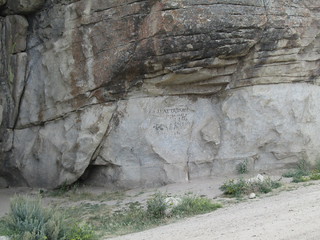
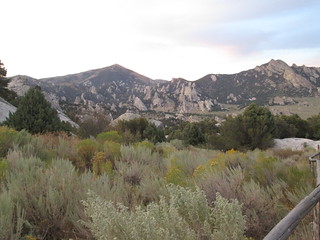 Pioneers
of the California Trail came through here from the Eastern USA and sometimes
left graffiti using axle-grease from wagons (photo at left). The California
Trail went from western Missouri across the Great Plains and into the Rocky
Mountains in Idaho, and then down into and across Nevada and into the gold
fields of northern California. It was most heavily used in the 1840s, 1850s,
and 1860s. The wagon trail from the Missouri River to Sacramento, California
was about 1,950 miles (3,138 km). We talked about this a lot that night,
about how long it took emigrants in wagon trains to do something in three
weeks that took us maybe half a day to do.
Pioneers
of the California Trail came through here from the Eastern USA and sometimes
left graffiti using axle-grease from wagons (photo at left). The California
Trail went from western Missouri across the Great Plains and into the Rocky
Mountains in Idaho, and then down into and across Nevada and into the gold
fields of northern California. It was most heavily used in the 1840s, 1850s,
and 1860s. The wagon trail from the Missouri River to Sacramento, California
was about 1,950 miles (3,138 km). We talked about this a lot that night,
about how long it took emigrants in wagon trains to do something in three
weeks that took us maybe half a day to do.
There are 64 campsites in City of Rocks, many
tucked tightly in among the granite fins and boulders. Some are at the
end of complicated, short curves on the dirt path through the campground,
and some require you to hike a bit from where you park to where you camp.
Some offer shade, via small trees or the rocks, some don't. Each is quite
isolated from others. All are good for tents, but very few are good for
people pulling campers or driving RVs, especially large ones. It is very
hard to get a campsite in this national reserve on the weekends. We were so
lucky to be there on a Tuesday - all the campsites had reservations for the
following Labor Day weekend. Almost all of the shaded campsites were taken
already, however, and the only open ones, at least that we saw and other
than the one we got, had no boundaries by rocks at all.
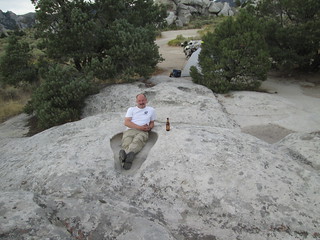 We
camped in a great site, one of the very few with a generous, flat parking
area, and therefore one I could actually drive into, and one that was also
an easy walk to the pit toilet. The views were stunning. It was like camping
in a dream world. We could see Practice
Rock from the site, and we sat and drank beer and watched
people climbing it and repelling down.
Stefan also looked particularly cute in one of the many natural tubs in
the rock. After setting up camp and changing clothes, we walked around
the area, watching two people climb a smaller rock near our camp. At one
point, I looked away for a second, and when I looked back, I saw something
falling off the rock. I gasped, afraid it was a person. It wasn't - it was
one of the bags a climber had taken up, and was throwing down.
We
camped in a great site, one of the very few with a generous, flat parking
area, and therefore one I could actually drive into, and one that was also
an easy walk to the pit toilet. The views were stunning. It was like camping
in a dream world. We could see Practice
Rock from the site, and we sat and drank beer and watched
people climbing it and repelling down.
Stefan also looked particularly cute in one of the many natural tubs in
the rock. After setting up camp and changing clothes, we walked around
the area, watching two people climb a smaller rock near our camp. At one
point, I looked away for a second, and when I looked back, I saw something
falling off the rock. I gasped, afraid it was a person. It wasn't - it was
one of the bags a climber had taken up, and was throwing down.
That night, we got yet another stunningly clear night and outstanding star
viewing. Looking at the Milky Way never gets old to me, and to do it in such
a beautiful, exotic place - what an incredibly lucky girl I am. We so long
to be in a place like this during a meteor shower. We really have to make
that happen.
Here's the
official web site for City of Rocks.
And in case you were wondering: I was so missing Lucinda and Gray Max. I
feel a tremendous amount of guilt and worry when I leave them. I'm still
looking for an affordable pet sitter that I really, really trust. I was
always able to find that in Germany, and was able to find it in Canby, but
not in Forest Grove.
Wednesday, Day 6
I got up three times in the night to pee. Yeah, I drank a LOT of water the
day before. It was HOT. I hate getting in and out of the tent... I love
sleeping in the tent, I love my sleeping bag, but I've had knees at
least 20 years older than me since I was in my 20s. And speaking of old
things: my sleeping bag and my Thermarest mattress are 26 years old. And are
better than anything sold now. My goodness the places they've been...
On this morning, we
cooked on one of the massive rocks instead of the picnic table. I also
saw two deer nearby poking their heads out amid the brush - wildlife
sightings are always fun, and I don't mind seeing deer when I'm NOT on my
motorcycle! We later packed up and before we left, two very young park
employees stopped to chat about our motorcycles. One was from Wasilla,
Alaska, and one was from New Jersey, and leaving early the next morning for
home. They were so nice - I love national reserve / monument / park
employees. The Alaskan told us we absolutely had to stop
and take the short hike to Window Arch and to stop at a water pump
with the sweetest water we'd ever tasted. He was right on both counts. At
the water pump, I met the only foreigner we met on the entire trip,
and that's incredibly unusual; on previous trips, we've met foreign
tourists, usually Germans, Swiss, Austrians, Australian or French, a few
times a week. We were realizing just how off-the-beaten-path we were with
this trip - not even the Europeans know about it!
We'd already seen so many amazing things, yet even people in the USA seemed
largely unaware of the awesome sights and sites of Idaho.
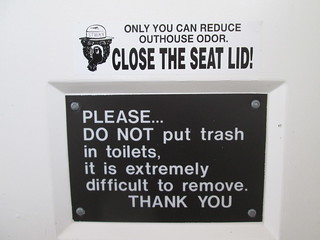 A
word about pit toilet etiquette: The sign in the photo at left, on the
bottom, is found most in pit toilets on BLM land and national forests
campsites. But we also saw this one, with the sticker on the top with
"Stinky" the bear saying "Only you can reduce outhouse odor." It should be
in all pit toilets. Most people don't know pit toilet etiquette, so
let me remind you. You ALWAYS put the seat lid down when you're done, and
you ALWAYS close the door - you never prop it open. That keeps both the bugs
and the stink down. And you never, ever put food or trash in the pit toilet,
because a human being has to pull that out.
A
word about pit toilet etiquette: The sign in the photo at left, on the
bottom, is found most in pit toilets on BLM land and national forests
campsites. But we also saw this one, with the sticker on the top with
"Stinky" the bear saying "Only you can reduce outhouse odor." It should be
in all pit toilets. Most people don't know pit toilet etiquette, so
let me remind you. You ALWAYS put the seat lid down when you're done, and
you ALWAYS close the door - you never prop it open. That keeps both the bugs
and the stink down. And you never, ever put food or trash in the pit toilet,
because a human being has to pull that out.
We drove
out of City of Rocks and onto Birch Creek Road - still gravel - and
headed to Oakley.
My materials from the Idaho tourism office said Oakley was historic, but it
seemed quite sad. There are a few historic houses here and there, but not
much in between them, and most of the main street seemed closed. There's
many more historic houses in my home town of Henderson, Kentucky! Oakley,
Idaho really needs an RV park. I bet a lot of people would love to
camp there, and have running water, and spend the day in City of Rocks
nearby. The town really needs sandwich boards that say "Open" outside of any
business that is open, because we really couldn't tell what was open and
what was closed. I later learned that people descended from the town's
Mormon founders include Jon Huntsman and Mitt Romney. I saw a public park,
and public bathrooms behind it, next to public pool, and hoped they were
open. They were. We had a short break, then
headed North, through the very sad town of Burley, and North and West
on state road 24, through some very boring, mostly flat, very empty land.
We went through Shoshone, and found it charming. It looked much more like a
historic town worth visiting than Oakley. Had we not already been to Craters
of the Moon, we absolutely would have taken the turn off and headed there,
but we headed North instead. We skipped the privately-run Shoshone Bird
Museum of Natural History - it was described to us as "unusual", and based
on where my imagination took me - nope. We did stop at the
Shoshone Ice Cave, which at least three people had suggested we visit.
It's surrounded by lava fields, similar to Craters of the Moon. It's also
privately owned and run, and is a classic
American tourist trap, complete with cheesy
dinosaur statue being ridden by an "Indian" in the front and an
amazing amount of kitsch for sale. We arrived just as a cave tour was
starting, and we scrambled to join up, as we would have had to wait an hour
for the next one. The cave really is full of ice all over the cave floor,
and there is a rickety
raised platform that allows you to walk over it. The guide, who was
reciting her speech from memory, said that, indeed, the ice does sometimes
come up to, and a bit over, the rickety platform sometimes. There is a
cinder cone relatively near by - the guide says it takes a full day to hike
there, up it, and back to the ice cave - and I could clearly see it from the
ground, but surprisingly, couldn't find it on Google
Earth. And if you want to see something really cool, go to Google
Earth and look for Shoshone Indian Ice Caves. You will be able to see the
black lava fields that flowed from this area to Gooding, and be able to see
the nearby, and related, lava flows of Craters of the Moon. It's super
fascinating. Well, it is to me. I'm a science geek.
It was, as usual, stupid, ridiculously, unbearably hot as we left the site.
There was lava
on either side of the road. We headed North, continuing on state road
75, which becomes the Sawtooth Scenic Byway, Idaho. We stopped at the
Albertson's in Hailey, Idaho. And we were surrounded by rich people, by
Western State Mountain chic. We'd gone from dusty cowboys in pickups to
people wearing the latest fashions and driving the latest SUVs. We felt so
out of place. The aisles in the grocery were tiny, because most people were
pushing the little tiny shopping carts, not the big ones. We bought beer and
some homemade bread. More about that later. I was really tired and so ready
to stop for the day. We asked the check out guy if there was a place to
camp, and he said "Redfish." Just so you know - that's 70 miles away, and
there's lots of camping much closer to Hailey. It wasn't the first time we
asked for advice on where to camp and gotten bad advice.
We were in another world, one of incredible amounts of money and privilege.
We drove through the oh-so-chic city of Ketchum and elite resort city of Sun
Valley, and it made me think of Jackson Hole, Wyoming. And not in a good
way. What a life...
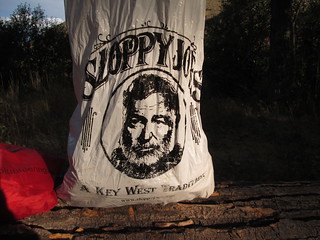 After
we passed the main Sun Valley resort, I saw a sign for "Hemingway Memorial."
Of course! Ketchum, Idaho! Hemingway lived here! In fact, he died here -
it's where he killed himself. Later, I noticed that one
of the plastic bags we were using to keep stuff water proof was from
Key West, Florida and had Hemingway's photo on it. We've never been to Key
West - Stefan thinks it's a bag from his parents. So, yeah, who knew - this
is the year of Hemingway for me! First
Havana, and his house, in February, and now Ketchum!
After
we passed the main Sun Valley resort, I saw a sign for "Hemingway Memorial."
Of course! Ketchum, Idaho! Hemingway lived here! In fact, he died here -
it's where he killed himself. Later, I noticed that one
of the plastic bags we were using to keep stuff water proof was from
Key West, Florida and had Hemingway's photo on it. We've never been to Key
West - Stefan thinks it's a bag from his parents. So, yeah, who knew - this
is the year of Hemingway for me! First
Havana, and his house, in February, and now Ketchum!
Sun Valley is historic luxury resort that's long drawn celebrities and the
oh-so-wealthy. Gary Cooper was a frequent visitor to the resort, and to
Hemingway's house, as were Clark Gable, Errol Flynn, Lucille Ball, Marilyn
Monroe, and several members of the Kennedy family. Big movie stars still
come to Sun Valley. And here we were, a couple of trashy, stinky bikers
driving through, looking over at the well-heeled skeet shooters at the gun
club and thinking, what are we doing here? I'm surprised no one
called the police.
And, then, suddenly, we were in wilderness. No houses, no nuthin'. We drove
to Boundary campground, and before we even turned in, saw the sign saying
the camp site was full. Damn! For an hour, we drove around looking for a
place to camp. We took the turn at Corral Creek, an easy gravel and dirt
road, and saw designated primitive camping sites on the left hand side of
the road - no picnic tables - a few of them occupied, but no pit toilet
anywhere. After passing camp site 8 or so and feeling like the road was
about to end, we turned around and went back to Trail Creek Road and drove
up it, seeing many more people camping rough off the road. We came to Park
Creek Campground, also full, and continued on, heading to Phi Kappa
Campground. But then the road turned to gravel and went severely uphill and
I stopped and refused to go on. It was getting dark and starting to drizzle,
we'd been riding all day - NO. We both were really hoping for a camp site
with a pit toilet, something we both really need in the mornings, for
reasons I won't go into... But we realized that we had to go back to Corral
Creek, get a primitive camp site, and just get up early the next morning and
head to Boundary campground for our morning pit toilet needs.
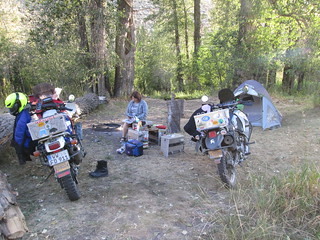 We
camped in one of the last open sites near Corral Creek, and felt
really isolated, in a great way. No picnic table? No problem - we used a
massive downed log next to our site, as well as our bike panniers, for
tables and chairs (and remember - motorcycle
panniers are available for purchase from Stefan/coyotetrips). We
didn't even try to use the fire pit - things just felt way, way too dry for
that. Stefan used the
charger I got from TechSoup to charge his cell phone - I forgot the
other charger I have, but was doing well plugging into bathrooms and RV
sites here and there.
We
camped in one of the last open sites near Corral Creek, and felt
really isolated, in a great way. No picnic table? No problem - we used a
massive downed log next to our site, as well as our bike panniers, for
tables and chairs (and remember - motorcycle
panniers are available for purchase from Stefan/coyotetrips). We
didn't even try to use the fire pit - things just felt way, way too dry for
that. Stefan used the
charger I got from TechSoup to charge his cell phone - I forgot the
other charger I have, but was doing well plugging into bathrooms and RV
sites here and there.
It was another super peaceful night of camping with excellent stars, this
time with the gurgle of water nearby. I love that, though I sometimes think
I'm hearing a conversation - it's amazing how flowing water can sometimes
sound like distant voices. The moon was far from full and not rising for any
part of the night we were awake, the weather was clear, and we were getting
so spoiled with these gorgeous views of clear night skies.
Thursday, Day 6
I slept 11 hours that night. That's the third time I'd done so on this trip.
It felt wonderful. Stefan said we were at 6450 feet in elevation, higher
than Silver
City, Idaho. We sure weren't as cold as Silver City at night. Probably
because this canyon gets much more sun.
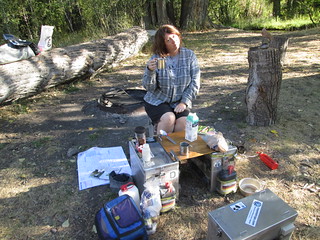 We
got up early the next day to have our simple breakfast - me having bread and
peanut butter, Stefan having bread, cold cuts, and cheese. And coffee, of
course. And as he cut into that high-end bread prepared for the ultra chic,
Stefan said, "Why do rich people get the good bread?" And I laughed and
laughed and laughed. Stefan also joked that we were camping for free and we
could head to Ketchum now for a $50 breakfast. We did not do that, BTW. But
he was on a roll...
We
got up early the next day to have our simple breakfast - me having bread and
peanut butter, Stefan having bread, cold cuts, and cheese. And coffee, of
course. And as he cut into that high-end bread prepared for the ultra chic,
Stefan said, "Why do rich people get the good bread?" And I laughed and
laughed and laughed. Stefan also joked that we were camping for free and we
could head to Ketchum now for a $50 breakfast. We did not do that, BTW. But
he was on a roll...
We were almost ready to leave at 10 a.m. on the dot, earlier than we'd ever
made it out before. I don't like to be in a rush in the mornings, I really
do like to savor beautiful mornings, but I also really love the ride in the
morning - it's the best of the day. We had maybe 10 minutes to go before
being all packed up, and then got a visit from two BLM employees, and
learned that driving past those "no motorized vehicle" signs with, say,
motorcycles, so that your vehicle can be near your tent, can mean a $250
fine per vehicle, and that fine usually happens when a law enforcement
person stops by rather than a BLM employee. I'm not going to say further how
we learned that. But we're just really glad we didn't end up with the most
expensive night of camping, that the people that stopped were BLM employees
and not law enforcement...
We stopped at the Boundary campground to use the pit toilets, and on the way
there, saw lots of rich people out walking their dogs - in fact, every day
use site at the campground had a note reminding people that dogs must be on
leashes at all times. The camp host walked over to talk to us as Stefan
smoked - I thought he was going to hit us up to pay the day use fee because
we used the pit toilets, but he didn't. For a guy wearing "One nation under
GOD" t-shirt, he was really nice. I asked him about the Hemingway
memorial, and he downplayed it - said it was just a plaque. I
looked it up online as I wrote this travelogue, and saw that it's much
more. At first, I was really sad I didn't go. But upon reflection, what
better way to pay tribute to Hemingway than to camp in the wilderness he
loved so much? But I am very sorry that I didn't know Hemingway is buried in
Ketchum. I remember passing the cemetery - I would have liked to have
stopped and paid my respects. For Whom the Bells Tolls is one of my
very favorite books. I also found out that Hemingway's Ketchum residence is
owned by the Nature Conservancy’s Silver Creek Preserve, but is not open to
the public. The Conservancy took ownership of the house in 1986, but
manuscripts, correspondence and most historical artifacts from the house
were given to the John F. Kennedy Presidential Library.
We headed out on state road 75, the Salmon River Scenic Byway, Idaho, and
saw lots of campgrounds along the road, but I suspect they were all full the
night before, and as it was now almost the weekend, they would be full
tonight as well. We also passed a National Forest ranger station and
information center, and I had said I wanted to stop at the next one we saw,
but it was so early - we blew right past it.
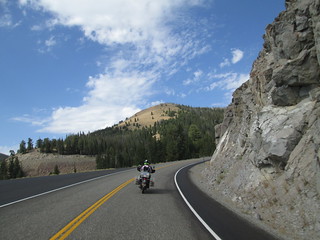 Then
the road got interesting: up and up and, at one point, very curvy. And I
went into my usual anxiety: don't stop, watch the road, look where you want
to go, keep going, don't stop or you will stall and fall over! Oh how I hate
that feeling. I so need to get over it. After several curves - none of them
hairpin - I saw a place off to the side of the road where I thought I could
stop safely, in
front of an Idaho history sign. And
I did. It was still very steep, but at least it was downhill, which is
easier for me to start from than uphill. The views were stunning. It seemed
to me that most traffic was going South, while we were going North.
Then
the road got interesting: up and up and, at one point, very curvy. And I
went into my usual anxiety: don't stop, watch the road, look where you want
to go, keep going, don't stop or you will stall and fall over! Oh how I hate
that feeling. I so need to get over it. After several curves - none of them
hairpin - I saw a place off to the side of the road where I thought I could
stop safely, in
front of an Idaho history sign. And
I did. It was still very steep, but at least it was downhill, which is
easier for me to start from than uphill. The views were stunning. It seemed
to me that most traffic was going South, while we were going North.
And I want to take this opportunity now to give another shout out to the Idaho
State Historical Society for doing such an excellent sign for those
big history signs it has all over the state of Oregon. They not only provide
interesting stories about the area, and are huge and easy to see, they also
almost always provide great place pull over and rest for a bit. It was
interesting to see Lewis and Clark affiliations on so many of them - the
more you travel around Oregon and Idaho, the more you feel like that
traveling party was everywhere.
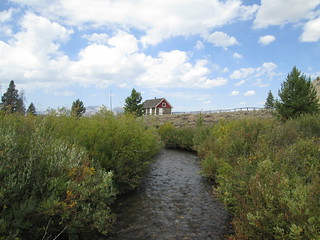 The
landscape was becoming breath-taking. I saw a sign pointing to a historic
ranger station that said it was just three miles away, and pulled off. I
talked to a guy wearing a Google t-shirt and driving an ATV there at the
turnoff, and he said it was interesting enough to visit, and that the road
was easy. He was right - it was a
very easy gravel road, past Dead Cow Ranch, to Pole Creek Ranger
Station. Built in 1909, its primary ranger, Bill Horton, kept
a journal of his life there in that one-room building. He fenced off a
pasture for his horses next to the station, an act that would provide an
important area for the scientific study of native plant species. The cabin
is not much to see, but the view is incredible, and I liked standing there
and thinking about life there, a life that must have been both busy and
lonely, and one where you had to welcome strangers. Unfortunately, you can't
see inside the cabin. There's a pit toilet in the parking lot, FYI. There
isn't much info online about Bill Horton - that should be addressed.
The
landscape was becoming breath-taking. I saw a sign pointing to a historic
ranger station that said it was just three miles away, and pulled off. I
talked to a guy wearing a Google t-shirt and driving an ATV there at the
turnoff, and he said it was interesting enough to visit, and that the road
was easy. He was right - it was a
very easy gravel road, past Dead Cow Ranch, to Pole Creek Ranger
Station. Built in 1909, its primary ranger, Bill Horton, kept
a journal of his life there in that one-room building. He fenced off a
pasture for his horses next to the station, an act that would provide an
important area for the scientific study of native plant species. The cabin
is not much to see, but the view is incredible, and I liked standing there
and thinking about life there, a life that must have been both busy and
lonely, and one where you had to welcome strangers. Unfortunately, you can't
see inside the cabin. There's a pit toilet in the parking lot, FYI. There
isn't much info online about Bill Horton - that should be addressed.
We continued on in Sawtooth National Forest, nearing the border with the
Salmon-Challis National Forest. I turned off the for ranger station in
Stanley. We went in and asked questions about any nearby fires. The young
ranger was a little smug as she emphasized the importance of "planning ahead
for camping" - which is great if you are in a car and can carry lots of
guides and plan your trip down to the hour and always have cell phone access
so you can call the day before to reserve a camp site. I picked up a guide
to the Salmon-Challis National Forest and it turned out to be ESSENTIAL for
our journey. We went back to our bikes and up drove a
guy on an older KLR than mine. His name is Brian and he's from
California. He has friends doing the Idaho
Backcountry Discovery Route (IDBDR), which he had been trying to do as
well, but found too difficult, so he was doing his own alternative route.
Brian seemed like quite an experienced rider, and is very tall, so if he is
having difficultly with the IDBDR, then I would never be able to do it - I
was really glad I'd avoided the route in planning our trip.
Brian told us about where he'd camped the night before: a small, primitive
campground with a pit toilet, about a mile past the historic ghost town of
Custer. Our ears immediately perked up. HISTORIC GHOST TOWN?!? We are all
about historic ghost towns! Everything he said about the campground and
Custer said, "Jayne and Stefan need to be here!" He gave us info on how to
find the town: the turnoff was at Sunbeam, onto Yankee Fork Road, and there
were a few campgrounds on the way there after the turnoff. There's no sign
for the ghost town on the highway, and that is SUCH a huge mistake!
We thanked Brian profusely for the info and pushed on to Stanley for lunch.
Stanley is mainly off the highway, not along the highway, and has a terrific
restaurant and bar across from the town's gas station. The bar hosts bands
in the summer, I was thrilled to see that Dale Watson had been there the
year before. Stanley would be a really great place to base yourself for
spending a couple of days to explore the area, enjoy rafting... some day...
And then it was time to go find Custer!
Part 4: Historic Custer, Idaho
Part 5
- Ft. Missoula, Montana
- Wallace, Idaho
- Lake Coeur d'Alene, Idaho
- White Pine Scenic Byway, Idaho
- Hell's Canyon Overlook, Oregon
- Joseph, Oregon
- Painted Hills, Oregon
- Little Crater Lake, Oregon
Know when I travel by:
Following me me at My @jayne_a_broad
Twitter feed 
This Twitter feed is focused on my experiences traveling, camping, riding
my motorcycle or my bicycle, taking mass transit (buses and trains),
commuting by walking or bicycling, and various other mostly-personal
interests.
Liking my Jayne A Broad
Facebook page 
This Facebook fan page is where I follow USA state parks, national parks,
national forests, and organizations focused on sustainable tourism, getting
children, women and under-represented groups outdoors, and related
international organizations and sites. My travel-related tweets from the my
jayne_a_broad twitter feed (see below) get posted here automatically.
Return to the broads abroad home page
Disclaimer
Any activity incurs risk. The author assumes no responsibility for the use
of information contained within this document.
A Broad Abroad | contact me
The content of this page is by
by Jayne Cravens, 2006-2016, all rights reserved
 While
waiting for the tire fix, Stefan
got to see a new Honda Africa Twin in person. The original version of
the bike, the one he has, was never sold in the USA, and it stopped being
made altogether in 2003 - or, at least, they ran out of stock and stopped
selling it then. This new version just started production, and the dual
sport world has been all abuzz about it. He
looked good on it! The Canyon Honda staff were all super nice, spent a
lot of time with us in the showroom that they didn't have to, and we so
appreciated them working us in to fix the bike. Since Progressive / Agero
was no help, we will always be thankful to that tow truck driver for taking
us there and sweet talking them into fixing the tire for us.
While
waiting for the tire fix, Stefan
got to see a new Honda Africa Twin in person. The original version of
the bike, the one he has, was never sold in the USA, and it stopped being
made altogether in 2003 - or, at least, they ran out of stock and stopped
selling it then. This new version just started production, and the dual
sport world has been all abuzz about it. He
looked good on it! The Canyon Honda staff were all super nice, spent a
lot of time with us in the showroom that they didn't have to, and we so
appreciated them working us in to fix the bike. Since Progressive / Agero
was no help, we will always be thankful to that tow truck driver for taking
us there and sweet talking them into fixing the tire for us.  It
cooled off in the night. Oh how glorious it felt. But the day was quickly
heating up - another day hot-as-Hades. We walked around the campground,
something I like to always do the night we arrive or in the morning, to
stretch my legs and rest my mind. We found horseshoes at the other end of
the park and tried to play. We're really, really bad! Even with that walk,
we were ready to leave at 10 a.m. Mountain time.
It
cooled off in the night. Oh how glorious it felt. But the day was quickly
heating up - another day hot-as-Hades. We walked around the campground,
something I like to always do the night we arrive or in the morning, to
stretch my legs and rest my mind. We found horseshoes at the other end of
the park and tried to play. We're really, really bad! Even with that walk,
we were ready to leave at 10 a.m. Mountain time.  We
went through Almo, Idaho, which is advertised as historic, but just seemed
like another sad, barely-hanging-on small town. I found out later that the
town long commemorated a massacre
of pioneers by Indians that probably never happened: in 1938, the Sons
and Daughters of Idaho Pioneers erected a marker in remembrance of the Almo
Massacre of 1861, in which, supposedly, a wagon train of nearly 300 pioneers
was surrounded and slaughtered by Indians. However, the earliest written
record of this event is from 1927, and the total absence of information
about either the slaughtered pioneers or the six survivors has led the Idaho
State Historical Society to recommend the removal of the marker. And so:
good for the Idaho State
Historical Society for righting this wrong! Let's face it: most
massacres went the other way, and are rarely commemorated with a monument.
We
went through Almo, Idaho, which is advertised as historic, but just seemed
like another sad, barely-hanging-on small town. I found out later that the
town long commemorated a massacre
of pioneers by Indians that probably never happened: in 1938, the Sons
and Daughters of Idaho Pioneers erected a marker in remembrance of the Almo
Massacre of 1861, in which, supposedly, a wagon train of nearly 300 pioneers
was surrounded and slaughtered by Indians. However, the earliest written
record of this event is from 1927, and the total absence of information
about either the slaughtered pioneers or the six survivors has led the Idaho
State Historical Society to recommend the removal of the marker. And so:
good for the Idaho State
Historical Society for righting this wrong! Let's face it: most
massacres went the other way, and are rarely commemorated with a monument. 
 Pioneers
of the California Trail came through here from the Eastern USA and sometimes
left graffiti using axle-grease from wagons (photo at left). The California
Trail went from western Missouri across the Great Plains and into the Rocky
Mountains in Idaho, and then down into and across Nevada and into the gold
fields of northern California. It was most heavily used in the 1840s, 1850s,
and 1860s. The wagon trail from the Missouri River to Sacramento, California
was about 1,950 miles (3,138 km). We talked about this a lot that night,
about how long it took emigrants in wagon trains to do something in three
weeks that took us maybe half a day to do.
Pioneers
of the California Trail came through here from the Eastern USA and sometimes
left graffiti using axle-grease from wagons (photo at left). The California
Trail went from western Missouri across the Great Plains and into the Rocky
Mountains in Idaho, and then down into and across Nevada and into the gold
fields of northern California. It was most heavily used in the 1840s, 1850s,
and 1860s. The wagon trail from the Missouri River to Sacramento, California
was about 1,950 miles (3,138 km). We talked about this a lot that night,
about how long it took emigrants in wagon trains to do something in three
weeks that took us maybe half a day to do.  We
camped in a great site, one of the very few with a generous, flat parking
area, and therefore one I could actually drive into, and one that was also
an easy walk to the pit toilet. The views were stunning. It was like camping
in a dream world. We could see Practice
Rock from the site, and we sat and drank beer and watched
people climbing it and repelling down.
Stefan also looked particularly cute in one of the many natural tubs in
the rock. After setting up camp and changing clothes, we walked around
the area, watching two people climb a smaller rock near our camp. At one
point, I looked away for a second, and when I looked back, I saw something
falling off the rock. I gasped, afraid it was a person. It wasn't - it was
one of the bags a climber had taken up, and was throwing down.
We
camped in a great site, one of the very few with a generous, flat parking
area, and therefore one I could actually drive into, and one that was also
an easy walk to the pit toilet. The views were stunning. It was like camping
in a dream world. We could see Practice
Rock from the site, and we sat and drank beer and watched
people climbing it and repelling down.
Stefan also looked particularly cute in one of the many natural tubs in
the rock. After setting up camp and changing clothes, we walked around
the area, watching two people climb a smaller rock near our camp. At one
point, I looked away for a second, and when I looked back, I saw something
falling off the rock. I gasped, afraid it was a person. It wasn't - it was
one of the bags a climber had taken up, and was throwing down.  A
word about pit toilet etiquette: The sign in the photo at left, on the
bottom, is found most in pit toilets on BLM land and national forests
campsites. But we also saw this one, with the sticker on the top with
"Stinky" the bear saying "Only you can reduce outhouse odor." It should be
in all pit toilets. Most people don't know pit toilet etiquette, so
let me remind you. You ALWAYS put the seat lid down when you're done, and
you ALWAYS close the door - you never prop it open. That keeps both the bugs
and the stink down. And you never, ever put food or trash in the pit toilet,
because a human being has to pull that out.
A
word about pit toilet etiquette: The sign in the photo at left, on the
bottom, is found most in pit toilets on BLM land and national forests
campsites. But we also saw this one, with the sticker on the top with
"Stinky" the bear saying "Only you can reduce outhouse odor." It should be
in all pit toilets. Most people don't know pit toilet etiquette, so
let me remind you. You ALWAYS put the seat lid down when you're done, and
you ALWAYS close the door - you never prop it open. That keeps both the bugs
and the stink down. And you never, ever put food or trash in the pit toilet,
because a human being has to pull that out.  After
we passed the main Sun Valley resort, I saw a sign for "Hemingway Memorial."
Of course! Ketchum, Idaho! Hemingway lived here! In fact, he died here -
it's where he killed himself. Later, I noticed that one
of the plastic bags we were using to keep stuff water proof was from
Key West, Florida and had Hemingway's photo on it. We've never been to Key
West - Stefan thinks it's a bag from his parents. So, yeah, who knew - this
is the year of Hemingway for me! First
Havana, and his house, in February, and now Ketchum!
After
we passed the main Sun Valley resort, I saw a sign for "Hemingway Memorial."
Of course! Ketchum, Idaho! Hemingway lived here! In fact, he died here -
it's where he killed himself. Later, I noticed that one
of the plastic bags we were using to keep stuff water proof was from
Key West, Florida and had Hemingway's photo on it. We've never been to Key
West - Stefan thinks it's a bag from his parents. So, yeah, who knew - this
is the year of Hemingway for me! First
Havana, and his house, in February, and now Ketchum!  We
camped in one of the last open sites near Corral Creek, and felt
really isolated, in a great way. No picnic table? No problem - we used a
massive downed log next to our site, as well as our bike panniers, for
tables and chairs (and remember - motorcycle
panniers are available for purchase from Stefan/coyotetrips). We
didn't even try to use the fire pit - things just felt way, way too dry for
that. Stefan used the
charger I got from TechSoup to charge his cell phone - I forgot the
other charger I have, but was doing well plugging into bathrooms and RV
sites here and there.
We
camped in one of the last open sites near Corral Creek, and felt
really isolated, in a great way. No picnic table? No problem - we used a
massive downed log next to our site, as well as our bike panniers, for
tables and chairs (and remember - motorcycle
panniers are available for purchase from Stefan/coyotetrips). We
didn't even try to use the fire pit - things just felt way, way too dry for
that. Stefan used the
charger I got from TechSoup to charge his cell phone - I forgot the
other charger I have, but was doing well plugging into bathrooms and RV
sites here and there.  We
got up early the next day to have our simple breakfast - me having bread and
peanut butter, Stefan having bread, cold cuts, and cheese. And coffee, of
course. And as he cut into that high-end bread prepared for the ultra chic,
Stefan said, "Why do rich people get the good bread?" And I laughed and
laughed and laughed. Stefan also joked that we were camping for free and we
could head to Ketchum now for a $50 breakfast. We did not do that, BTW. But
he was on a roll...
We
got up early the next day to have our simple breakfast - me having bread and
peanut butter, Stefan having bread, cold cuts, and cheese. And coffee, of
course. And as he cut into that high-end bread prepared for the ultra chic,
Stefan said, "Why do rich people get the good bread?" And I laughed and
laughed and laughed. Stefan also joked that we were camping for free and we
could head to Ketchum now for a $50 breakfast. We did not do that, BTW. But
he was on a roll...  Then
the road got interesting: up and up and, at one point, very curvy. And I
went into my usual anxiety: don't stop, watch the road, look where you want
to go, keep going, don't stop or you will stall and fall over! Oh how I hate
that feeling. I so need to get over it. After several curves - none of them
hairpin - I saw a place off to the side of the road where I thought I could
stop safely, in
front of an Idaho history sign. And
I did. It was still very steep, but at least it was downhill, which is
easier for me to start from than uphill. The views were stunning. It seemed
to me that most traffic was going South, while we were going North.
Then
the road got interesting: up and up and, at one point, very curvy. And I
went into my usual anxiety: don't stop, watch the road, look where you want
to go, keep going, don't stop or you will stall and fall over! Oh how I hate
that feeling. I so need to get over it. After several curves - none of them
hairpin - I saw a place off to the side of the road where I thought I could
stop safely, in
front of an Idaho history sign. And
I did. It was still very steep, but at least it was downhill, which is
easier for me to start from than uphill. The views were stunning. It seemed
to me that most traffic was going South, while we were going North.  The
landscape was becoming breath-taking. I saw a sign pointing to a historic
ranger station that said it was just three miles away, and pulled off. I
talked to a guy wearing a Google t-shirt and driving an ATV there at the
turnoff, and he said it was interesting enough to visit, and that the road
was easy. He was right - it was a
very easy gravel road, past Dead Cow Ranch, to Pole Creek Ranger
Station. Built in 1909, its primary ranger, Bill Horton, kept
a journal of his life there in that one-room building. He fenced off a
pasture for his horses next to the station, an act that would provide an
important area for the scientific study of native plant species. The cabin
is not much to see, but the view is incredible, and I liked standing there
and thinking about life there, a life that must have been both busy and
lonely, and one where you had to welcome strangers. Unfortunately, you can't
see inside the cabin. There's a pit toilet in the parking lot, FYI. There
isn't much info online about Bill Horton - that should be addressed.
The
landscape was becoming breath-taking. I saw a sign pointing to a historic
ranger station that said it was just three miles away, and pulled off. I
talked to a guy wearing a Google t-shirt and driving an ATV there at the
turnoff, and he said it was interesting enough to visit, and that the road
was easy. He was right - it was a
very easy gravel road, past Dead Cow Ranch, to Pole Creek Ranger
Station. Built in 1909, its primary ranger, Bill Horton, kept
a journal of his life there in that one-room building. He fenced off a
pasture for his horses next to the station, an act that would provide an
important area for the scientific study of native plant species. The cabin
is not much to see, but the view is incredible, and I liked standing there
and thinking about life there, a life that must have been both busy and
lonely, and one where you had to welcome strangers. Unfortunately, you can't
see inside the cabin. There's a pit toilet in the parking lot, FYI. There
isn't much info online about Bill Horton - that should be addressed. ![]()